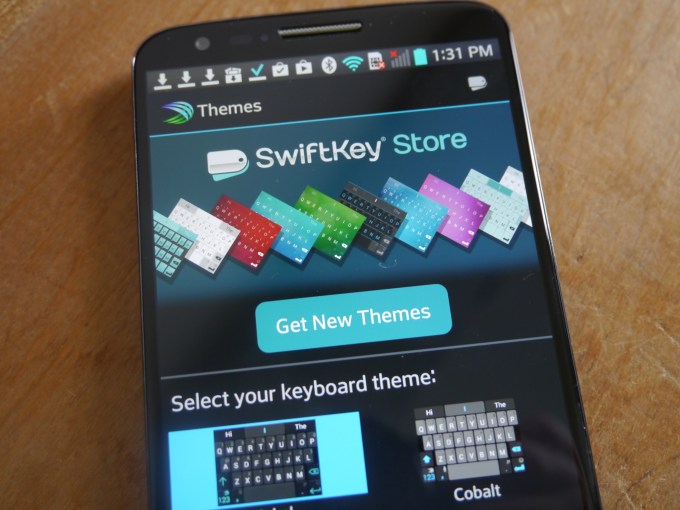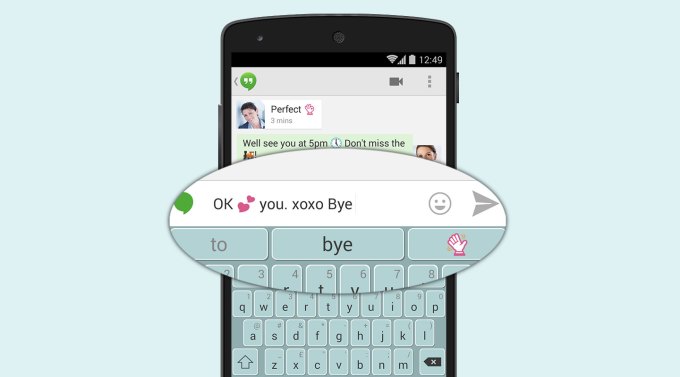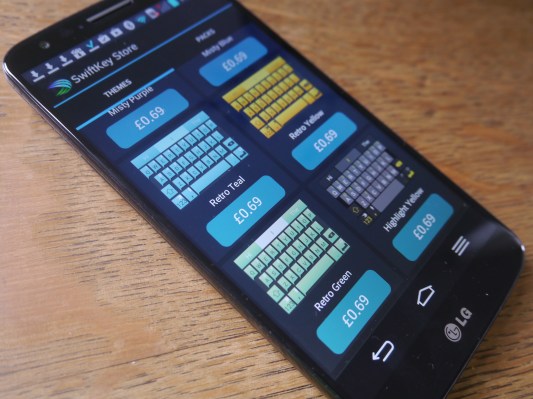SwiftKey, the startup that makes the popular eponymous Android word-predicting keyboard software — which last year pulled in $17.5 million in funding from Index, Accel and Octopus — is switching its consumer keyboard app from a $3.99 paid download to free.
The full machine learning keyboard technology, which adapts to its users’ use of language so it can better predict their next likely words, is now free, with additional customization options offered as in-app purchases to pay for the switch. So SwiftKey is basically going freemium.
The free app (v5 of SwiftKey’s keyboard software) is available from today on Google Play. SwiftKey says it’s still in talks with Amazon so the free version is not currently on Amazon’s App Store.
The switch is a significant shift of business strategy for the UK startup, as the SwiftKey app has been a paid download since 2010 (not counting its free one-month trial app — which now goes away).
Other mobile users have also been able to use SwiftKey’s technology without paying for it themselves because certain device makers preload the keyboard by licensing it directly from SwiftKey.
“We’ve fundamentally been a paid app since SwiftKey was first released in 2010 and we’ve been thinking about this for a while and we now believe the right approach for us, looking ahead for the next couple of years, is to make it a free app,” said SwiftKey co-founder and CTO Ben Medlock in a briefing with TechCrunch.
“It allows us to reach a much wider user base. Originally we launched the product as paid because we wanted to prove that people would pay for it — primarily because we were really focused on our licensing business. It was a lot easier to persuade [companies] to license the technology if people were paying for it. But going free it follows the heart of the app market.”
Medlock pointed to the growing trend of freemium apps as one trigger for the decision.
Another cited factor in SwiftKey’s thinking is the growing importance of emerging markets to app makers, such as China and India, where requiring payments for an app is an even bigger barrier to adoption than elsewhere.
“We’ve very excited about going head to head with the big name apps which all exist in the free app space,” Medlock added. “It’s a step up for us… We’ve had 20 million+ downloads to date and I believe this gives us a shot at order of magnitude increases on that.”
A whole new market opening up
It’s certainly interesting timing for SwiftKey to make this switch, given last week’s Apple keyboard-related news coming out of WWDC. Apple announced it was adding its own version of SwiftKey-style next-word prediction technology in iOS 8, called QuickType, which put it on a course to compete directly with the startup.
But — in the same WWDC keynote — Apple also said it would finally be opening up support for third party system wide keyboards. That’s something alternative keyboard makers had long been hoping for. In SwiftKey’s case, the wait has been some four years.
It’s now firing on all cylinders to bring the full SwiftKey experience to iOS in time for iOS 8’s fall user release, said Medlock.
There really is a chance of getting to a billion end-points. SwiftKey
It’s worth noting that SwifKey’s decision to switch from paid to free predates the Apple announcements. But the opening up of the iOS ecosystem now puts a huge new potential user-base within its reach.
Asked specifically whether SwiftKey is gunning to become a billion-user business, Medlock said that sort of scale is “not completely out of range”, pointing out that there are some 300 to 400 million users on iOS that will soon be coming within the orbit of SwiftKey’s app.
“If you look at the proliferation of touchscreen devices I think there really is a chance of getting to a billion end-points,” said Medlock. “Using the technology, we currently have somewhere north of 200 million [active devices] — that’s through a combination of our licensing deals and our app downloads… And we’re just ramping up now to really focus on distribution.”
Medlock confirmed that SwiftKey’s current licensing business will remain as is, with its existing “multi-year deals” staying the same. Although, once those deals expire, there’s less likelihood the licensees will want to shell out again for something that their users can now get for free anyway — not unless SwiftKey offers them additional customization options.
In the meantime, Medlock said the shift to a free consumer app does give SwiftKey more flexibility to make deals with device makers in developing markets who may not have been in a financial position to license its technology before.
So again, going free is about SwiftKey grabbing as many emerging market users as it can.
“On the one hand those [licensing] relationships can remain as they are but on the other hand it also gives us a way of distributing with partners for whom the freemium proposition actually makes a lot of sense,” said Medlock. “For partners in [emerging markets] a deal where they are paying licensing revenue in some cases you just will never be able to sell that.”
“This [freemium] proposition doesn’t just allow us to distribute more effectively through the app store channels, it also allows us to distribute more effectively through those b2b channels,” he added.
The SwiftKey Store

Returning to the consumer app, the new business model for SwiftKey is “paid for content”, with optional customization offerings on sale within a SwiftKey store, also launching today.
The initial paid offerings will be keyboard themes, giving users the ability to tweak the look and feel of their SwiftKey keyboard, with different colours, key shapes and trail colours (for SwiftKey’s finger-dragging typing option, Flow).
Individual themes are priced at £0.69/$0.99. With packs of five costing £1.99/$2.99 and packs of 10 costing $4.99.
SwiftKey has had customizable themes before — but it’s expanding what’s on offer to stock the virtual shelves of its new store with 30 new themes, including retro looking keyboards, and brightly coloured panels that do away with marked boundaries between the letters.
Additional custom paid content is likely coming to the store in future but SwiftKey is keeping its power dry on what the future holds there at this point.
The company was also keen to stress that users who have already paid for its software will not be required to pay again to buy back any functionality they already have. Existing users who paid for the app will also get a premium pack of themes to download for free to reward them for their loyalty.
In addition to going free, SwiftKey is also rolling recent beta offerings, such as emoji and a dedicated number row, into the new version of its app, and has given the visuals a “complete overhaul”, as Medlock put it.

“In some ways it’s one of the most complex releases we’ve ever made because in order to facilitate the store, to make sure all that stuff works and we’re tracking the customization of content that people are downloading it’s actually quite an intricate proposition. But we absolutely feel like it’s the right thing to do,” he added.
Free to grow
SwiftKey has previously discussed its ambitions to push its technology into as many devices as possible. And with the proliferation of connected objects there are of course increasing numbers of potential touchscreen surfaces where people may want to type.
It’s also continuing to expand its linguistic reach — recently releasing a Japanese beta version of its software to reach into more markets, for instance.
Going free removes perhaps the biggest barrier to getting huge numbers of people using its technology. And puts it in plumb position to capitalize on high rates of smartphone adoption in emerging markets — assuming its tech is able to effectively handle new linguistic complexities.
Japanese has been a long time coming to SwiftKey, and it’s still yet to offer support for Chinese.
Being free also gives SwiftKey the ability to out-shine paid rivals, such as Swype (although rivals may not have to reconsider their pricing strategies) — or indeed compete with preloaded freebies like Apple’s native QuickType offering when that lands in iOS 8.
“We see the technology as being as broad as possible,” said Medlock. “It’s a platform for us now.”
Asked whether it is raising a new funding round to underpin its new freemium strategy, Medlock said the startup doesn’t currently need to raise more funding. So not an out-and-out no then.
“Partly what we were doing [in our last funding round] was setting ourselves up so that we had the right partners to go through the next phase and that may well include a further raise at some point,” said Medlock.
“Thankfully we’re in a good position financially — partly as a result of the raise last year and partly because our revenue have been very strong as well to this point, but we are in a position where we are very much able to manage the transition. It’s in our own power to do that.
“So a further raise would be something that we might choose to do in order to make further investments in a future technology but it’s not something we need to do at this point.”
As for what happens to Note, SwiftKey’s first iOS app — which launched in January to give Apple users a taster of its tech within a single note-taking app, pulling in around a million downloads in its first month — that’s tbc now that Apple is opening up to SwiftKey proper. A dedicated SwiftKey note-taking app likely becomes redundant if you can have SwiftKey anywhere on your iOS device.
“Whatever happens to Note, there’s now a really clear focus for us on iOS — which is great,” added Medlock.
